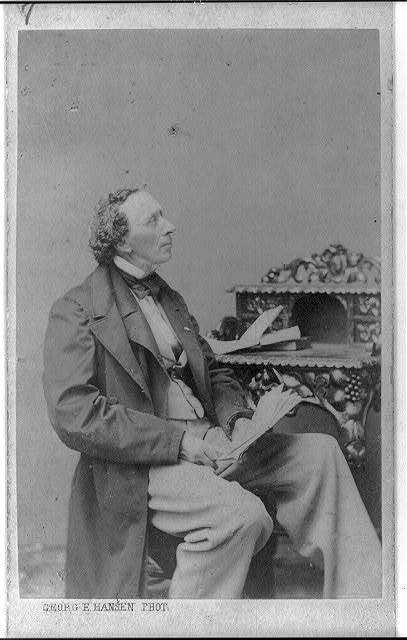On this day in 1835, the first installment of Hans Christian Andersen’s Fairy Tales was published by C. A. Reitzel in Copenhagen, Denmark. Hans Christian Andersen is often referred to as the “father of modern fantasy.” Centuries after his birth, Andersen’s tales are still enjoyed by both young and old alike.
Hans Christian Andersen is known for his stories like The Little Mermaid, Thumbelina, and The Princess and the Pea. Expressions such as “an ugly duckling” and “the emperor’s new clothes” are based on Andersen’s tales of the same names. Andersen also wrote novels, poems, plays, travel descriptions, and he created travel illustrations, drawings, and artistic paper cuts (using a surprisingly large pair of scissors!)
This blog post from the Library of Congress shares more about the paperwork, scrapbooks, cutouts, and billedbog (a Danish word for picture book) that were created by Hans Christian Andersen and some collaborators. There are also numerous links to the primary sources themselves.
The Library of Congress has a number of Hans Christian Andersen’s manuscripts that can be viewed and also downloaded. There are texts published in 1884, 1899, 1902, 1909, 1911, 1916, and 1923.
Since so many of Hans Christian Andersen’s stories have been adapted and abridged into animated movies, invite students to compare the film version and the original story, looking at the similarities and differences between the two versions of the tale. Students could also be encouraged to explain which version they prefer and why.
Hans Christian Andersen lives on through the award in his name. The Hans Christian Andersen Award is the highest international recognition given to an author and an illustrator of children’s books, awarded every other year by the International Board on Books for Young People. The Hans Christian Andersen Awards recognize lifelong achievement and are presented to an author and an illustrator whose complete works have made an important, lasting contribution to children’s literature. The Author’s Award has been given since 1956 and the Illustrator’s Award since 1966.
How do you use the work of Hans Christian Andersen?
Curious about the NCTE and Library of Congress connection? Through a grant announced by NCTE Executive Director Emily Kirkpatrick, NCTE is engaged in ongoing work with the Library of Congress, and “will connect the ELA community with the Library of Congress to expand the use of primary sources in teaching.” Stay tuned for more throughout the year!
It is the policy of NCTE in all publications, including the Literacy & NCTE blog, to provide a forum for the open discussion of ideas concerning the content and the teaching of English and the language arts. Publicity accorded to any particular point of view does not imply endorsement by the Executive Committee, the Board of Directors, the staff, or the membership at large, except in announcements of policy, where such endorsement is clearly specified.

